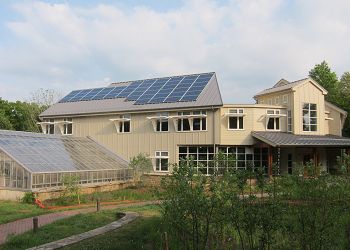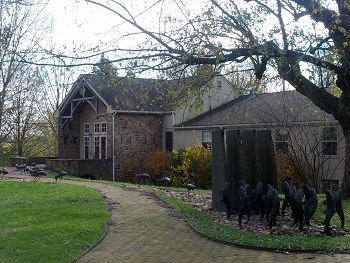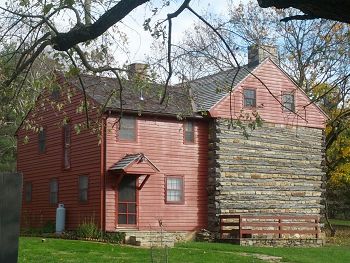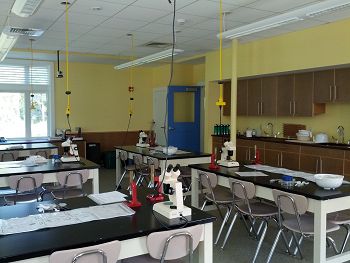Logistical Infrastructure
The result of four decades of building and renovation, Stroud Water Research Center's campus is modern and well-equipped, overlooking a gentle stream and situated on a country lane. It seems a place of contrasts — rustic in appearance yet sophisticated in operation, filled with art and devoted to science. Perhaps above all, it evokes a sense of warmth and comfort that is an ideal climate in which research can flourish.
The LEED-certified Moorhead Environmental Complex at Stroud Water Research Center. Photo: Bernard Sweeney (Stroud Water Research Center)
Growing With the Science
Stroud Water Research Center sits on the site of an 18th-century barn, whose original stone wall was incorporated into the first conference room.
Stroud Water Research Center began its existence in 1966 in a hastily cleared space above Joan and Dick Stroud’s garage. The Center's original building was completed in early 1968. It housed seven research laboratories, a library/seminar room, offices, technical staff areas and storage space. Within six years, the research programs had outgrown their original walls, and additional space was required for graduate and post-doctoral students who wanted to work at the Center. When the additions were completed in late 1976, the Center had adequate space to offer courses to university students, provide opportunities for professional groups to come and learn about new research findings, and host a public lecture series which featured distinguished scientists discussing significant environmental issues.
Seventeen years later it became clear that the growing research and education programs had again outgrown their space. Laboratories for invertebrate biology and toxicology studies were added, storage areas for collections and office space for visiting scientists were enlarged, a new teaching laboratory was designed for school groups, the meeting room was expanded to hold 175 people comfortably and a lunch room was added.
When the new areas were opened in October 1996, the 24,820-square-foot facility was four times the size of the original building. The final project of this phase — a new streamhouse for both research and education — was dedicated in October 1999.
One of the most striking aspects of Stroud Water Research Center is how well its design reflects the rural character and heritage of Chester County, a direction encouraged by the Stroud family. The building sits on the site of an 18th-century barn, whose original stone wall was incorporated into the first conference room. The architecture of the education center was taken from that of two Quaker meeting houses nearby. And what appeared to be a run-down house across the courtyard from the laboratory turned out instead to be a 1710 cabin whose log walls had been preserved as well as camouflaged by clapboard siding. It has been restored to its original style and now houses visiting scientists.
On May 30, 2012, Stroud Water Research Center dedicated the Moorhead Environmental Complex. This new “green” building was built as a direct and proactive way to support the Center’s environmental education and public outreach. Even though the Moorhead Environmental Complex occupies only a small portion of our site, the innovations associated with its construction have made all elements of the “water cycle” more sustainable for the entire campus. The new building will utilize and treat water in a way that more closely mimics nature — leaving a smaller overall environmental footprint, better protecting the White Clay Creek, and acting as both a teaching vehicle and a replicable model for others to follow.
The result of all the building and renovation is a modern, well-equipped campus overlooking a gentle stream and situated on a country lane. It seems a place of contrasts — rustic in appearance yet sophisticated in operation, filled with art and devoted to science. Perhaps above all, it evokes a sense of warmth and comfort that is an ideal climate in which research can flourish.
Stroud Water Research Center sits on the site of an 18th-century barn, whose original stone wall was incorporated into the first conference room.
Education lab in the Moorhead Environmental Complex at Stroud Water Research Center
The log cabin on the Stroud campus dates to 1710 and is often used to house visiting scientists.
Explore Further




